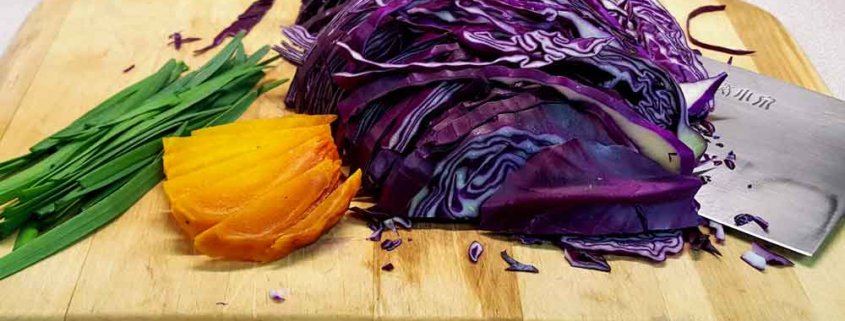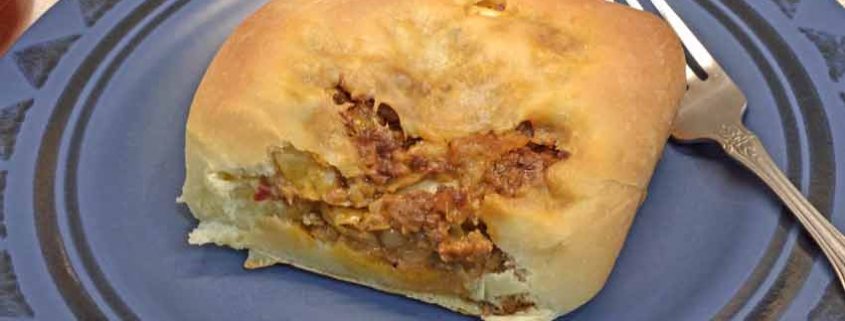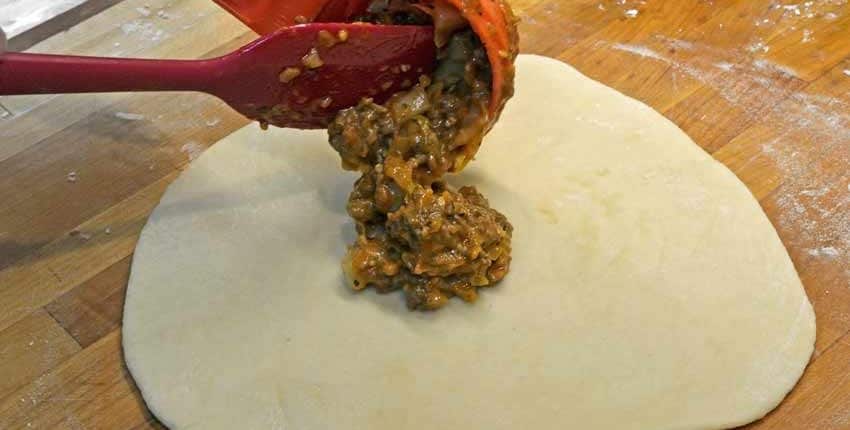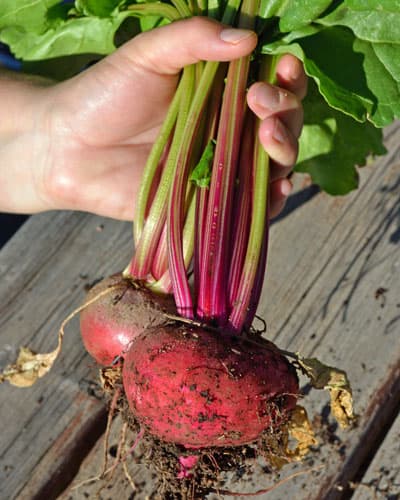Elevate your coleslaw game with Chipotle-Cilantro Coleslaw. This recipe features roasted golden beets for a unique and delicious twist.
Tag Archive for: Cabbage
The Original Working Lunch
All over the world, working folks have eaten hand-held lunches of meat or vegetables wrapped in dough. Not sandwiches, but delicious and filling sealed, portable, savory pies – bringing energy for the afternoon work they faced.
Many of these international specialties have found a welcome home in this country, and this example comes from the 18th-century Russian Mennonite farms by way of south-central Kansas, where they emigrated to. Traditionally tucked into a basket or hamper and brought to the farmers at their mid-day lunch break, they are a hearty and delicious way to enjoy a good meal on the go today.
They are great fresh, but also keep in the refrigerator and freeze well. Let them thaw before reheating to get a taste of fresh, homemade goodness anytime!
Bierocks perfectly showcase fresh, home-grown cabbage as a foil for the richness of seasoned ground meat or other roasted, savory vegetables like mushrooms or beets. We used a freshly harvested head of Danish Ballhead cabbage that was sweet, tangy and crunchy!
It starts with the dough, which has been mixed, kneaded and risen twice. These balls are rolled out…
…and filled with the savory filling. Equal parts ground beef mixed with cabbage is traditional, but any seasoned ground meat is just as tasty, or use portobello mushrooms sauteed in Worcestershire sauce for a meatless variation.
Seal the bierock by folding the edges together around the filling and pinch tightly to seal the dough together. To make a nicer, easier to handle pastry…
…fold the “tails” or ends underneath and seal them with a strong pinch.
Arrange them onto a baking sheet – we used parchment paper instead of oiling the pan. Let them rise for 20 – 25 minutes…
…then pop them into a hot oven for 15 – 20 minutes, or until golden or golden-brown on top.
They are ready to serve after sitting for a few minutes, or you can make them ahead of time for a party or trip. Bierocks re-heat well and make a satisfying field lunch when spending the day outdoors.
Here’s the recipe –
- 1 tsp active dry yeast
- 5 cups bread flour
- 1/2 cup sugar
- 1/2 tsp salt
- 1 1/2 cups milk - lukewarm
- 10 tbsp butter - melted
- 2 eggs - lightly beaten
- 3 tbsp oil - coconut or olive
- 1 yellow onion - peeled and finely chopped
- 1 lb ground beef
- 4 cups green cabbage - shredded
- 1/4 lb chedder cheese - grated
- 2 tbsp dijon mustard
- black pepper - freshly ground to taste
- For the dough:
Dissolve yeast in 2tbs warm water in a small bowl. Mix together flour, sugar, and 1/2 tsp salt in a large bowl. Add milk, 8 tbs butter and eggs to yeast, mix well then stir into flour. If the flour is too dry and crumbly, add water 1tbs at a time until a dough ball is formed. Turn dough out onto a lightly floured surface and knead until elastic - about 5 minutes. If using a stand mixer, use the dough hook to knead, then turn out and test elasticity by hand kneading. Put dough into an oiled bowl, turn it to coat with oil, cover with a cloth and set aside in a warm place to rise for about 30 minutes. Once the dough has doubled in size, punch down, cover and let rise for additional 30 minutes. While dough is rising, make the filling.
- For the filling:
Heat 2tbs oil in a large skillet over medium-low heat. Add onions and cook until soft and starting to brown - about 15 minutes. Increase heat to medium-high, add beef, and brown for 8 minutes. Stir in cabbage, cook for 10 minutes, then add cheese and mustard and season to taste with salt and pepper. Simmer for 5 minutes more, then set aside to cool.
- To assemble:
Preheat oven to 350°F. Return dough to a floured surface and divide into 12 equal balls. Roll out into 6" rounds and spoon about 1/3 cup of filling into the center, then fold edges together and pinch closed. Fold tips together and pinch to seal, then place seam side down on an oiled or parchment-lined baking sheet. Let rise for 20 minutes after all bierocks are made, then bake until tops are golden, about 15 - 20 minutes.
- Serve either hot out of the oven, warmed up or cold depending on your need.
Let us know how you like them, and what fillings you use in yours!
Ellen shares her research on the history of beets today. Did you know that beets weren’t always the deep red we are familiar with, but that characteristic was selected for and bred into them in the 1700’s? Lighter red existed much earlier than that, but not in the blood-red shades we know today.
Make sure to visit our Beet department and grow your own tasty varieties! Don’t forget to try both recipes at the end of today’s article.
Beet (Beta vulgaris)
The beet as we know it today is a handsome vegetable. It is rooted in the ground, transferring the earthy taste of good soil through its deep red root. The beet is an old vegetable, ascribed with aphrodesiac and blood strengthening qualities. Its wild ancestor, the sea beet (Beta vulgaris sp. Maratima) is not a sweet vegetable–it is a bunched mass of greens with a slender white-yellow root that grows almost on the tide line of the ocean.
The beet as we know it today has a larger, fleshier, and darker colored root than the seabeet. The seabeet grows wild along the Mediterranean coast, down the coast of the Corsican sea. The sea beet has the heart-shaped leaves, deep glossy green color, and bunching tendencies of garden beets. Today, we almost equivocally think of beetroot, as it is commonly called in Britian, New Zealand, and Australia, as blood-red. In fact, red pigmentation was selected and bred into the beet in the mid 18th century. While white colored beets are not common in the public marketplace, they are the leading beet grown for sugar production.
Another common cultivar of beta vulgaris is Swiss chard, whose name comes from a bastardization of the Sicula–the leafy green that Swiss chard is most likely descended from. Swiss chard is grown for its large leaves, which offer a near year-round source of leafy greens–with white, red, or rainbow colored ribs. Beet greens taste remarkably similar to chard and in fact the beet is the same as Swiss chard, but it has been bred to produce large edible roots, rather than put that energy into leaf production.
Anyone who has tasted a fresh beet can attest to its earthy, mineral taste. For those who find red beets to be too intense, the yellow or lighter fleshed cultivars offer a good substitute. More mellow tasting varieties include Golden Detroit and Chioggia beets. Chard’s buttery texture and almost ‘healthy’ taste is unbeatable, and I almost always feel better for eating it.
The sweetness of beets is well known. The vegetable has been associated in many cultures with love; it is said if a man and a woman eat from the same beet, they will fall in love. Aphrodisiac qualities were well-known in the beet in Ancient Greece and in Roman times. The red beet was hung on the walls of prostitution houses in 740 AD and again in the early 20th century. The beet is an old symbol of love and lust–and wealth. In Delphi, a beet was said to be worth its weight in silver, and was offered to Apollo to ensure wealth.
Today, the beet is well known and loved by gardeners and small growers. Its color and sweet taste are a welcome mix to the bitter greens and other green vegetables that are available in the spring months. Traditionally, there were three kinds of beets in cultivation. The sugar beet is used to produce sugar and was developed in Upper Silesia (now Poland) in the 1740’s. The majority of Europe’s sugar at the time was coming to the continent via the British colonies in the Caribbean. The sugar beet became better known when Napoleon Bonaparte announced an embargo with the British in 1813 and endorsed the growing and processing of sugar beets.
The process of extracting sugar from beets continues today in America and Europe, with Russia producing 1/6th of the world’s sugar beets. They are commercially grown all over the United States, concentrated in the Midwest and into Washington and Colorado States. Today, 20-30% of the world’s sugar comes from the sugar beet. As in Napoleons time, the United States sugar beet industry grew immensely after we enforced an embargo with Cuba, which was the major source of sugar for the United States.
The second type of beet is a forage beet, or manglewertzle, which simply means “root beet”. They are grown as livestock feed and are either left in the ground for sheep or other animals to uproot or grown, harvested, and fed out during the winter months. These varieties of beet have quickly lost popularity and are the most genetically threatened. One well-known Pennsylvania revival is Deacon Dan’s, which William Woys Weaver calls, “the field pumpkins of the beet world…some can weigh as much as 15 pounds but they need good, sandy soil to develop such large size.”
The most well known beets are those of the garden. They are typically red, although if you look closely, there are many shades of red, pink, even yellow to be found in garden beets today. They come in a variety of shapes, from perfectly spherical to flattened on the bottom half, to cylindrical. The garden beet is used for pickling, canning, eating fresh, roasted, and really, however you can think to enjoy them!
For some, the beet releases memories of vinegary pickles, or generic canned red vegetable, or the inevitable stained fingers one gets when preparing cooked beets. Beets food uses extend into food coloring, dyes, and even making tomato sauces more red. Nothing beats a fresh beet! Beets are served many ways, from shredded raw into a salad, roasted, or made into a soup. Borscht is a traditional soup from Ukraine–it is said there are as many recipes for borscht as there are villages throughout Eastern Europe. I enjoy this delightfully colored soup all year long, served chilled or hot. If borscht is not your thing, try the roasted beet salad with feta and cilantro.
Here’s what could come out of your garden for this recipe – Beets, Onion, Carrots, Cabbage and Dill!
Here’s what could come out of your garden for this recipe – Beets and Cilantro!Traditional BorschtBorscht is a traditional Eastern European soup that is served either hot or cold. There are many different variations, but this is a good starting point.Servings: 4Ingredients
- 2 large or 3 medium beets thoroughly washed
- 2 large or 3 medium potatoes sliced into bite-sized pieces
- 4 Tbsp of cooking oil
- 1 medium onion finely chopped
- 2 carrots grated
- 1/2 head of cabbage thinly chopped
- 1 can kidney beans with their juice
- 2 bay leaves
- 10 cups water and 6 cups broth to get 16 cups liquid total
- 5 Tbsp ketchup
- 4 Tbsp lemon juice
Instructions
Serve with a dollop of sour cream if serving hot. To serve chilled, simply make a day in advance and refrigerate. Take out about 15 minutes to a half hour before serving so the flavors will be noticeable.
Serves 4 as a meal, or 6 as an introductory courseRoasted Beet SaladThe richness of the roasted beets are offset and enhanced by the tang of the cheese and hint of apple cider vinegar.Servings: 4Ingredients
- 1-2 lbs beets red and yellow make a beautiful salad, but one or the other will do
- Feta or soft goat cheese
- Olive oil
- Apple cider vinegar
- Salt and pepper
- 1/2 bunch cilantro
Instructions
Serves 4 as a side salad.

 © 2024 Terroir Seeds | Underwood Gardens
© 2024 Terroir Seeds | Underwood Gardens








